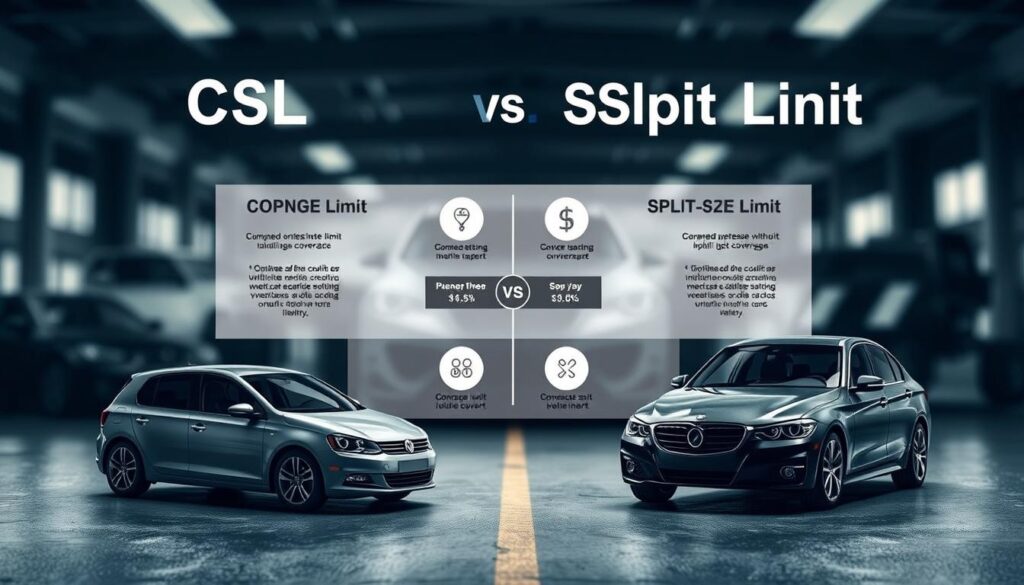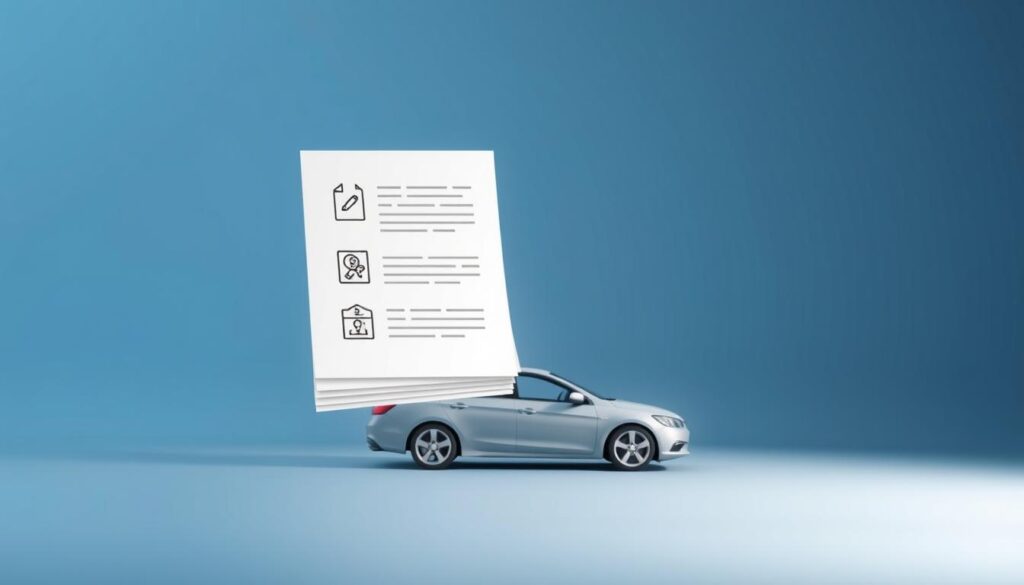Having the right auto insurance coverage is key to protecting yourself and your assets on the road. Recently, Combined Single Limit (CSL) auto insurance has become more popular. CSL auto insurance offers a single limit for both bodily injury and property damage liability.
This coverage can make your insurance policy simpler and might lower your premiums. Knowing how CSL auto insurance works helps you make better choices for your insurance needs.
Key Takeaways
- CSL auto insurance provides a single limit of coverage for bodily injury and property damage liability.
- This type of coverage can simplify your insurance policy.
- CSL auto insurance may help reduce premiums.
- Understanding CSL auto insurance is essential for making informed decisions.
- CSL coverage can be beneficial for certain drivers.
What Is CSL Auto Insurance?
Auto insurance policies have many coverage options, including CSL, or Combined Single Limit. Knowing what CSL auto insurance is helps you make smart choices about your coverage.
Definition of Combined Single Limit
CSL, or Combined Single Limit, is a liability coverage type. It combines bodily injury and property damage into one limit. This means you have one amount for all accident-related costs, not separate ones.
For example, with a CSL policy of $500,000, you can use this money for medical bills, lost wages, or property repairs. It depends on what you need after an accident.
Key Features of CSL:
- Single limit for bodily injury and property damage
- Flexibility in allocating the limit to different expenses
- Simplified coverage understanding
How CSL Differs from Traditional Coverage
CSL is different from traditional split-limit liability coverage. Traditional coverage has separate limits for bodily injury per person, per accident, and property damage. For example, a split-limit policy might be $100,000/$300,000/$100,000.
This means $100,000 for bodily injury per person, $300,000 for per accident, and $100,000 for property damage. CSL, on the other hand, has a single limit. This gives you more flexibility in how claims are paid out.
| Coverage Type | Split-Limit | Combined Single Limit |
|---|---|---|
| Bodily Injury Per Person | $100,000 | $500,000 (Single Limit) |
| Bodily Injury Per Accident | $300,000 | |
| Property Damage | $100,000 |
Knowing the differences between CSL and traditional coverage helps you choose the best insurance for you.
Understanding Combined Single Limit Coverage
Combined Single Limit (CSL) coverage is a simple auto insurance option. It combines bodily injury and property damage liability into one limit. This means you have one limit for all expenses, not separate ones for each.
The Mechanics of CSL Policies
CSL policies offer a single coverage amount for accidents. For example, if an accident costs $200,000, your CSL policy will cover it up to your limit. This applies to bodily injury, property damage, or both.
This flexibility is great for complex accidents. CSL can adapt to a claim’s needs, reducing the risk of going over your coverage.
Examples of CSL in Action
Imagine you’re at fault in an accident with many vehicles and injuries. The total damage is $250,000. If your CSL policy limit is $300,000, it can cover the $250,000 easily.
CSL is also useful when there’s a lot of property damage but little injury. It can pay for the damage without being limited by lower property damage limits.
Learning about CSL policies and these examples helps you decide if it’s right for you.
CSL vs. Split Limit Liability Coverage
Understanding the difference between Combined Single Limit (CSL) and Split Limit Liability Coverage is key. Your choice affects your financial safety in case of an accident.
Split Limit Explained
Split Limit Liability Coverage splits your liability into three parts. These are for bodily injury per person, per accident, and property damage. For instance, a policy might have $100,000 for bodily injury per person, $300,000 for per accident, and $100,000 for property damage.

Key Differences Between CSL and Split Limits
CSL and Split Limit differ in how they handle damages. CSL has one limit for all damages, giving more flexibility. Split Limit has separate limits for different damages, which can be stricter but clearer.
Which Option Might Be Better for You
Choosing between CSL and Split Limit depends on your situation. If you want flexibility and possibly more protection, CSL might be right. But if you like clear limits for different damages, Split Limit could be better.
Benefits of CSL Auto Insurance
CSL auto insurance is great because it fits different situations. It offers a flexible and complete coverage solution for policyholders.

Flexibility in Claim Distribution
CSL auto insurance gives you flexibility in claim distribution. You can use the full limit for any mix of bodily injury and property damage claims. This means you can adjust coverage based on what you need in an accident.
Simplified Coverage Understanding
CSL insurance makes things easy with simplified coverage. It’s all in one limit, so you can easily see what you’re covered for. This clarity helps drivers know they’re protected.
Potential for Higher Overall Protection
Another big plus is the higher overall protection CSL auto insurance offers. With a single limit that can be used in different ways, you might get more protection against big financial losses in an accident.
To wrap it up, CSL auto insurance has many benefits. It offers flexibility, easy-to-understand coverage, and possibly more protection. It’s a good choice for drivers looking for solid auto insurance.
Potential Drawbacks of CSL Policies
CSL auto insurance has many benefits, but it also has some downsides. Like any insurance, CSL has its own set of limitations and possible drawbacks.
Cost Considerations
The cost of CSL auto insurance can be a big deal for many drivers. CSL policies might cost more than traditional split-limit policies, which can be pricey for higher coverage limits. It’s important to think about the cost and what you get in return.
For example, let’s compare the average annual premiums for CSL and split-limit policies:
| Coverage Type | Average Annual Premium |
|---|---|
| CSL $500,000 | $1,200 |
| Split Limit (100/300/100) | $1,050 |
Coverage Limitations to Be Aware Of
CSL policies have a big limitation: they might not cover enough in certain situations. For example, if you’re in an accident with many victims, a CSL policy might not have enough money for all claims.
Key limitations include:
- Insufficient coverage for complex claims
- Potential for higher costs without corresponding benefits
- Limited flexibility in certain jurisdictions

How Much Does CSL Auto Insurance Cost?
CSL auto insurance costs vary due to many factors. It’s important to know what affects your premiums. The cost can change a lot from one person to another.
Average Premium Ranges
The average cost of CSL auto insurance can vary a lot. It can be between $1,000 to $2,500 per year. But, your actual cost might be different based on your situation.
| Coverage Limit | Average Annual Premium |
|---|---|
| $500,000 | $1,200 |
| $1,000,000 | $1,800 |
Factors Affecting CSL Insurance Rates
Many things can change your CSL auto insurance rates. Your driving history, age, and where you live are important. Your credit score and claims history also matter.
- Driving history and record
- Age and driving experience
- Location and local regulations
- Type of vehicle and its safety features
Quote from an insurance expert: “Knowing what affects your CSL auto insurance rates can help you save money.”
“The key to affordable CSL auto insurance is understanding your risk profile and shopping around for the best rates.”
Ways to Save on CSL Coverage
To save on CSL auto insurance, try bundling policies and keeping a clean driving record. Look for discounts and compare quotes from different providers.

By understanding what affects CSL auto insurance costs, you can lower your premiums. This way, you can get good coverage without spending too much.
CSL Coverage for Different Types of Claims
CSL auto insurance offers coverage for many types of claims. This makes it easier for policyholders. It’s very helpful in complex situations with many factors involved.
Bodily Injury Scenarios are a key part of CSL coverage. If you’re at fault in an accident, CSL can help with the medical costs of others. For example, hitting a pedestrian means CSL can pay for their medical bills, up to your policy’s limit.
Bodily Injury Scenarios
In cases of bodily injury, CSL coverage has a single limit. This limit can cover different expenses. So, if many people are hurt, the total medical costs can be covered under one limit. This makes the claims process simpler.
Property Damage Applications
CSL coverage also covers property damage. If an accident damages someone else’s property, like a car or fence, CSL can help pay for repairs or replacement. This is very useful when the damage is big.
Multiple Victim Accidents
In accidents with many victims, CSL coverage is very helpful. The single limit can be split among different claims. This ensures everyone gets the compensation they need. It also makes the process simpler and less stressful for everyone involved.
For example, in a big accident with many cars, CSL can cover medical and property damage costs for everyone, up to your policy’s limit. This flexibility gives peace of mind in complicated situations.
State Requirements for CSL Auto Insurance
CSL auto insurance rules vary by state. Knowing these rules is key for following the law and getting good coverage.
States That Allow or Require CSL
Not every state lets you choose CSL auto insurance. Some states let you pick between CSL and split-limit coverage. Others might need you to have CSL or have special rules for it.
It’s important to check with your state’s insurance department. They can tell you if CSL is allowed or needed. This info helps you make the right insurance choice and follow the law.
Minimum Coverage Requirements by Region
CSL coverage needs change by region. Each state has its own CSL policy minimums. These can differ from split-limit policies.
For example, a state might need a CSL limit of $300,000. But the split-limit might be $100,000 per person for injury and $300,000 for accidents.
Knowing these regional needs is key for good coverage. Talk to insurance experts to find the right CSL limit for you. They can help you meet state rules.
How to Choose the Right CSL Limit for Your Needs
Choosing the right CSL auto insurance limit is important. You need to think about your personal risk and how much you can afford. A CSL limit that’s too low might not protect you well. But a limit that’s too high could make your insurance too expensive.
Assessing Your Personal Risk Factors
Your driving habits and how much you drive matter a lot. Also, think about your accident or traffic violation history. If you’re considered a high-risk driver, you might want a higher CSL limit to keep your assets safe.
Considering Your Assets and Net Worth
What you own and your net worth are key to picking a CSL limit. If you have a lot to lose, a higher CSL limit could offer more protection. Financial experts say it’s smart to match your insurance to your financial situation to manage risk well.
“The right insurance coverage is not just about complying with legal requirements; it’s about protecting your financial future.”
When to Consider Higher Limits
If you’re wealthy, at risk for lawsuits, or live in a high-litigation area, think about a higher CSL limit. Also, if you’ve had claims or live in a disaster-prone area, a higher limit could be a good idea.
By looking at these factors, you can pick a CSL limit that fits your needs. This way, you get the right amount of coverage without spending too much.
Conclusion: Making the Right Auto Insurance Choice
Now you know more about CSL auto insurance. You can make a smart choice about your auto insurance. CSL policies offer flexibility and more protection, but think about the costs and what’s covered.
When picking a CSL limit, think about your risk, assets, and net worth. Knowing these helps you choose the right coverage for you. Also, remember state laws and the types of claims you might face.
Choosing the right auto insurance is about finding a balance. By understanding CSL auto insurance, you can pick a policy that meets your needs. This way, you’ll feel safe and secure on the road.
FAQ
What is CSL auto insurance?
CSL auto insurance is a type of coverage. It has one limit for both bodily injury and property damage in an accident.
What does CSL mean in auto insurance?
CSL means Combined Single Limit. It’s a policy with one limit for both bodily injury and property damage.
What is the difference between CSL and split limit liability coverage?
CSL has one limit for all damages. Split limit liability has three parts: bodily injury per person, per accident, and property damage.
How does CSL auto insurance work?
CSL auto insurance has one limit for any damage in an accident. This gives flexibility in how claims are handled.
What are the benefits of CSL auto insurance?
CSL auto insurance offers flexibility and easier understanding. It can also provide more overall protection.
Are there any drawbacks to CSL auto insurance?
CSL auto insurance might cost more and have coverage limits. These should be thought about when choosing a policy.
How much does CSL auto insurance cost?
CSL auto insurance costs vary. It depends on your location, driving history, and coverage limit. Insurance providers offer average premium ranges.
Can I save on CSL auto insurance?
Yes, you can save by comparing rates and driving safely. Adjusting your coverage limits can also help.
Is CSL auto insurance required in my state?
CSL auto insurance rules differ by state. Some states require it, so check your state’s minimum coverage rules.
How do I choose the right CSL limit for my needs?
Choose the right CSL limit by thinking about your risk and assets. Consider your individual situation when deciding on higher limits.
